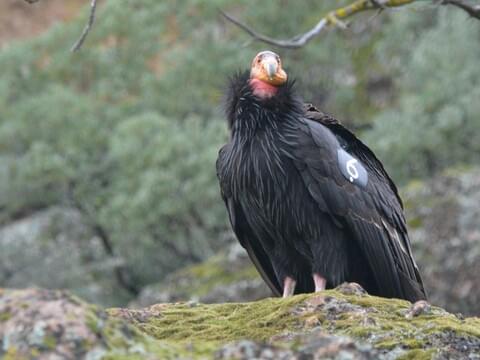|
|
Post by OldGreenVulture on Aug 4, 2019 9:10:44 GMT
 COMMON NAME: California Condor SCIENTIFIC NAME: Gymnogyps californianus TYPE: Birds DIET: Carnivore AVERAGE LIFE SPAN IN THE WILD: Up to 60 years SIZE: Body: 3.5 to 4.5 feet; wingspan: 9 to 10 feet WEIGHT: 18 to 31 pounds SIZE RELATIVE TO A 6-FT MAN:  ABOUT THE CALIFORNIA CONDOR ABOUT THE CALIFORNIA CONDORThe California condor is the largest flying bird in North America. Their wings may stretch nearly 10 feet from tip to tip. When in flight, these huge birds glide on air currents to soar as high as a dizzying 15,000 feet. ScavengingLike other vultures, condors are scavengers that feast on the carcasses of large mammals, such as cattle and deer. When a big meal is available, the birds may gorge themselves so much that they must rest for several hours before flying again. Population DeclineCondors were sacred birds to the Native Americans who lived in the open spaces of western America. Today, they are best known as the subjects of a famous captive breeding program that may save them from extinction. After decades of decline, condors neared the point of extinction in the late 1970s, when only two or three dozen birds survived. No one is sure exactly what cause or causes contributed most to this decline. Many birds died from poison ingestion and illegal egg collection, and all felt the steady loss of the open lands over which they once soared. Fossil records also show that the birds occupied only a fraction of their former range when Europeans first reached America—perhaps because of the loss of the great prehistoric herds that formerly roamed the continent. Conservation
California condors mature and reproduce slowly. They don't breed until they are between six and eight years old, and the female lays only one egg every two years. If that egg is removed, however, she will lay a second or a third. With this in mind, scientists began to collect eggs for captive incubation. They also captured wild birds for captive breeding and, when the wild population dropped below 10 individuals, all of the remaining wild condors were brought into captivity in 1987. Through the efforts of many organizations and individuals, reintroduction of California condors began in 1992. Though they are protected, mortality rates are still high from accidental death. Powerlines are a particular hazard for condors, and they fare better in areas where human population density is low. www.nationalgeographic.com/animals/birds/c/california-condor/ |
|
|
|
Post by OldGreenVulture on Aug 4, 2019 9:16:33 GMT
Cool FactsIn the late Pleistocene, about 40,000 years ago, California Condors were found throughout North America. At this time, giant mammals roamed the continent, offering condors a reliable food supply. When Lewis and Clark explored the Pacific Northwest in 1805 they found condors there. Until the 1930s, they occurred in the mountains of Baja California. One reason California Condor recovery has been slow is their extremely slow reproduction rate. Female condors lay only one egg per nesting attempt, and they don’t always nest every year. The young depend on their parents for more than 12 months, and take 6-8 years to reach maturity. Condors soar slowly and stably. They average about 30 mph in flight and can get up to over 40 mph. They take about 16 seconds to complete a circle in soaring flight. By comparison, Bald Eagles and Golden Eagles normally circle in 12–14 seconds, and Red-tailed Hawks circle in about 8–10 seconds. At carcasses, California Condors dominate other scavengers. The exception is when a Golden Eagle is present. Although the condor weighs about twice as much as an eagle, the superior talons of the eagle command respect. Condors can survive 1–2 weeks without eating. When they find a carcass they eat their fill, storing up to 3 pounds of meat in their crop (a part of the esophagus) before they leave. California Condors once foraged on offshore islands, visiting mammal and seabird colonies to eat carrion, eggs and possibly live prey such as nestlings. In cold weather, condors raise their neck feathers to keep warm. In hot weather, condors (and other vultures) urinate onto a leg. As the waste evaporates, it cools off blood circulating in the leg, lowering the whole body temperature. Condors bathe frequently and this helps avoid buildup of wastes on the legs. Adult condors sometimes temporarily restrain an overenthusiastic nestling by placing a foot on its neck and clamping it to the floor. This forceful approach is also a common way for an adult to remove a nestling’s bill from its throat at the end of a feeding. Young may take months to perfect flight and landings. “Crash” landings have been observed in young four months after their first flight. California Condors can probably live to be 60 or more years old—although none of the condors now alive are older than 40 yet. What’s in a name? The name “condor” comes from cuntur, which originated from the Inca name for the Andean Condor. Their scientific name, Gymnogyps californianus, comes from the Greek words gymnos, meaning naked, and refers to the head, and gyps meaning vulture; californianus is Latin and refers to the birds’ range. www.allaboutbirds.org/guide/California_Condor/overview
|
|



